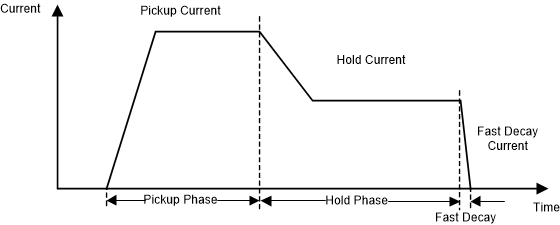SLVAF35A February 2021 – July 2024 DRV8714-Q1 , TPS2HB16-Q1
4 Coil Types and Control Requirements
The coil is a crucial component of high-voltage contactors as it provides the driving force to close the contacts. The current through the coil generates a magnetic field which attracts the moving core to close the contacts, and on the contrary open the contacts. Even though there are several high-voltage contactor vendors in the market, such as TE, Panasonic, GIGAVIC, and so on, the driving current requirements of all the contactor coils are similar. The current profile can be divided into three phases, as shown in Figure 4-1. The first phase is known as pickup phase, the current should be large enough and keep long enough to ensure the contactor is closed during the phase. The second phase is the hold phase, where a smaller current is kept to efficiently close the contactor and keep it closed. The last phase is current fast decay, during this phase the current drops very quickly to quench the contacts opening. Figure 4-1 shows the three phases requirement of the current curve, the actual currents in the pickup phase and hold phase could be PWM signals with maximum and minimum values.
 Figure 4-1 Coil Current With Three Phases
Figure 4-1 Coil Current With Three Phases Generally, the contactor vendors provide two contactor coil types: one is an economized coil with an internal economizer and the other is a non-economized coil that requires external economization. The economized coil integrates an internal economizer with one of several methods such as a two coil economizer, pulse-width modulation with voltage feedback, and pulse-width modulation with current feedback. It is only needed to power the two terminals of the coil and the desired current waveform is generated by itself with this internal economizer. The non-economized coil stands for this is only a coil without any internal circuit and needs external circuits to generate the desired current waveform.